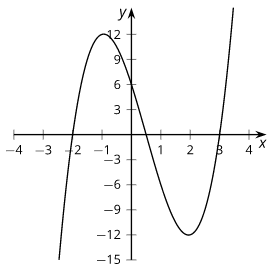Illustrative Math - Algebra 2 - Unit 2 - Lesson 9
By Formative Library
starstarstarstarstar
Last updated about 1 year ago
6 Questions
1
1.
Match the polynomial with its end behavior.
| arrow_right_alt | As x gets larger and larger in either the positive or negative direction, f(x) gets larger and larger in the positive direction. | |
| arrow_right_alt | As x gets larger and larger in the positive direction, f(x) gets larger and larger in the positive direction. As x gets larger and larger in the negative direction, f(x) gets larger and larger in the negative direction. | |
| arrow_right_alt | As x gets larger and larger in the positive direction, f(x) gets larger and larger in the negative direction. As x gets larger and larger in the negative direction, f(x) gets larger and larger in the positive direction. | |
| arrow_right_alt | As x gets larger and larger in either the positive or negative direction, f(x) gets larger and larger in the negative direction. |
F.BF.3
1
2.
State the degree and end behavior of f(x)=-x^{3}+5x^{2}+6x+1. Explain or show your reasoning.
F.BF.3
1
3.
The graph of a polynomial function f is shown. Select all the true statements about the polynomial.

F.BF.3
1
4.
Write the sum of 5x^{2}+2x-10 and 2x^{2}+6 as a polynomial in standard form.
F.BF.3
1
5.
State the degree and end behavior of f(x)=4x^{3}+3x^{5}-x^{2}-2. Explain or show your reasoning.
F.BF.3
1
6.
Select all the polynomial functions whose graphs have BIx-intercepts at x=4,-\frac{1}{4},-2.
F.BF.3
This lesson is from Illustrative Mathematics. Algebra 2, Unit 2, Lesson 9. Internet. Available from https://curriculum.illustrativemathematics.org/HS/teachers/3/2/9/index.html ; accessed 27/July/2021.
IM Algebra 1, Geometry, Algebra 2 is © 2019 Illustrative Mathematics. Licensed under the Creative Commons Attribution 4.0 International License (CC BY 4.0).
The Illustrative Mathematics name and logo are not subject to the Creative Commons license and may not be used without the prior and express written consent of Illustrative Mathematics.
These materials include public domain images or openly licensed images that are copyrighted by their respective owners. Openly licensed images remain under the terms of their respective licenses. See the image attribution section for more information.